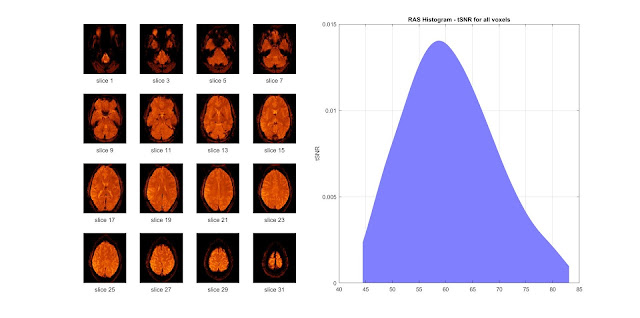fMRI noise
Measuring fMRI temporal SNR
In my previous post, I discussed two papers focusing on data processing in relation to fMRI noise. I had just finished writing a small routine to compute temporal SNR as described in Liu et al 2016 when the I saw the manuscript from Wald and Polimeni. In this one they discuss noise in relation to hardware and sequences, but also had some nice analyses - so I updated my tSNR function again !
Signal Mixture
Liu et al 2016 define tSNR as the mean signal/std over time, except that the standard deviation is estimated for BOLD, non-BOLD, and background. Practically, I estimate BOLD from gray matter, non-BOLD from white matter and CSF and background from whatever is not in the non-brain mask.
Interestingly, my estimates of background were biased by using a too small brain mask. Since in EPI we do not 'see' tissues like the skull, I made up my mask smoothing only a little GM, WM, CSF mask images - but plotting the spatial distribution of background noise shows how much we need to make sure to be away from the object under study. In the figure below, we can clearly see non-brain structures (eyes and skull), although this is tSNR from EPI T2* time series (subject1, run1 from Wakeman & Henson 2015).
Figure 1. tSNR from EPI T2* time series computed for all voxels.
What I'm still not sure about, is that thermal noise is supposed to be random and Gaussian distributed - but even with my improved (large) brain mask, tSNR is high in some regions and the distribution is clearly not Gaussian. For a good estimation of thermal noise, a quick acquisition with flip angle at 0 is likely the easiest.
Figure 2. tSNR from EPI T2* time series computed for background only.
Now in the brain, as Wald and Polimeni remind us, we also have lots of other sources of signal, task BOLD, resting state BOLD, changes in BOLD due to respiratory and cardiac cycles, slow changes in heart rate and in respiratory volume, B0 shifts associated to these cycles, tissue motion, low frequency vaso-motion, and CSF flow. That's a lot of mixed signals ! and importantly they are spatially correlated.
Noise spatial correlation
Why do we care about that since we do mainly mass-univariate analyses? Because the spatial structure of noise is what we need to know to check our clusters (I remind you that Random field theory related to Euler characteristics which is the 'number of clusters' in a thresholded image - see the excellent MRC-CBU wiki if you need to refresh your memory about that). Failure to have a good spatial model leads to a high false positive rate! (see Eklund et al. 2016). What Wald and Polimeni propose is acquisition schemes that tip the balance toward thermal noise, rendering spatial correlation weak, and thus SPM more valid. To do that they use the ratio SNR0 (that I estimate as signal in the image / std background) on tSNR. In short, they suggest to use high spatial resolution, typically using parallel imaging and simultaneous multi-slice acquisition, to have more thermal noise - since we have smaller voxel. On the other hand, what is not considered in this paper, is that high spatial resolution comes at a cost of stronger motion artefacts. Seems to me that, providing we can control motion during acquisition, task fMRI will benefit from high resolution imaging. For resting state, it might be tricker because we also want high temporal resolution, but we cannot get both.
my little routine now also returns a figure of tSNR and ratio, along with usual metric
tSNR =
GM: 48.2173
WM: 59.6527
CSF: 25.6565
Background_raw: [210×18774 double]
Background: 3.9870
average: 21.2317 % tSNR
image: 112.6303 % SNR0
SNR02tSNR_corr: 0.9997
SNR02tSNR_ratio: 0.9821
signal_mean: 105.4028
roi: [1×1 struct]
References
- Eklund et al. (2016). Cluster failure: Why fMRI inferences for spatial extent have inflated false-positive rates. PNAS
- Liu (2016) Noise contributions to the fMRI signal: An overview. NeuroImage
- Wald and Polimeni (2017) Impacting the effect of fMRI noise through hardware and acquisition choices – implications for controlling false positive rates. NeuroImage





Comments
Post a Comment